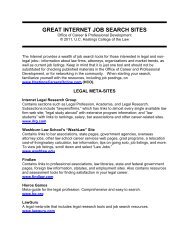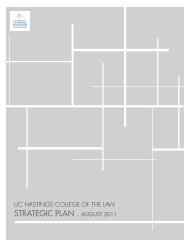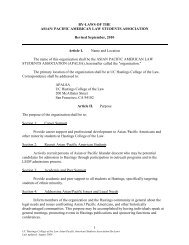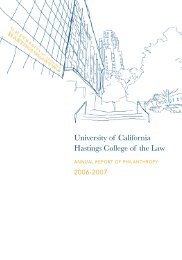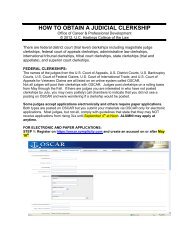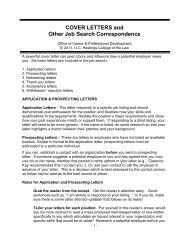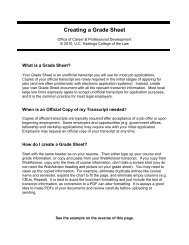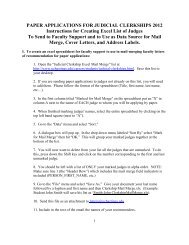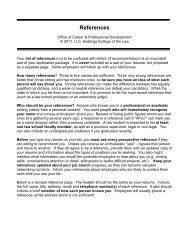Syllabus - Hastings College of the Law
Syllabus - Hastings College of the Law
Syllabus - Hastings College of the Law
Create successful ePaper yourself
Turn your PDF publications into a flip-book with our unique Google optimized e-Paper software.
<strong>Hastings</strong> <strong>College</strong> <strong>of</strong> <strong>the</strong> <strong>Law</strong><br />
Fall 2012 (Tues. 9:30-10:30; Thurs. 9:30-11:40) - Room 314 (198 building)<br />
Pr<strong>of</strong>essor Stephen Schwarz (Room 624, 200 building)<br />
(Tel: 415-565-4681; e-mail: schwarzs@uchastings.edu)<br />
REQUIRED MATERIALS:<br />
NONPROFIT ORGANIZATIONS<br />
<strong>Syllabus</strong><br />
Fishman & Schwarz, Nonpr<strong>of</strong>it Organizations: Cases and Materials (Foundation Press, 4th<br />
ed. 2010) (hereinafter "CB" for "Casebook")<br />
Fishman & Schwarz (eds.), Nonpr<strong>of</strong>it Organizations: Statutes, Regulations and Forms<br />
(Foundation Press, 4th ed. 2010) (hereinafter "Stat. Supp.")<br />
2012 Update Memorandum to Casebook. Distributed electronically and also posted on class<br />
web site, along with o<strong>the</strong>r occasional handouts.<br />
Application for Recognition <strong>of</strong> Exemption Under Section 501(c)(3) <strong>of</strong> <strong>the</strong> Internal Revenue<br />
Code (Form 1023) and Instructions-- on class web site and IRS web site; see also Stat.<br />
Supp. 1099-1126<br />
IRS PUBLICATIONS (available at http://www.irs.gov.charities)<br />
Tax-Exempt Status for Your Organization (Publication No. 557)<br />
Tax on Unrelated Business Income <strong>of</strong> Exempt Organizations (Publication No. 598)<br />
Charitable Contributions (Publication No. 526)<br />
and many o<strong>the</strong>r resources on IRS web site<br />
SELECTED PROFESSIONAL REFERENCE BOOKS<br />
California Attorney General's Guide for Charities available (with o<strong>the</strong>r publications) at<br />
http://oag.ca.gov/charities/publications.<br />
Hill & Mancino, TAXATION OF EXEMPT ORGANIZATIONS (Warren, Gorham & Lamont, 2002,<br />
with current supplement). Treatise, available on Westlaw.<br />
1
Hopkins, THE LAW OF TAX-EXEMPT ORGANIZATIONS (Wiley, 10th ed.). Ano<strong>the</strong>r treatise,<br />
available in library (KF6449.H6).<br />
Whaley, et al. (eds.), ADVISING CALIFORNIA NONPROFIT CORPORATIONS (California C.E.B.,<br />
3d ed. 2009). A good practical resource covering both federal and California law.<br />
Available in library (KFC342.A98).<br />
th<br />
Mancuso, HOW TO FORM A NONPROFIT CORPORATION IN CALIFORNIA (Nolo Press, 14 ed.).<br />
A “how to” resource that is useful for beginning or generalist lawyers who are helping<br />
to set up a new nonpr<strong>of</strong>it organization. Available in library (KFC342.M363).<br />
BLOGS (Selective list; for o<strong>the</strong>r Internet resources, see Stat. Supp. 1133-1137)<br />
Nonpr<strong>of</strong>it <strong>Law</strong> Blog. http://www.nonpr<strong>of</strong>itlawblog.com/<br />
Nonpr<strong>of</strong>it <strong>Law</strong> Pr<strong>of</strong> Blog. http://www.lawpr<strong>of</strong>essors.typepad.com/nonpr<strong>of</strong>it/<br />
GUIDESTAR<br />
Guidestar – http://www.guidestar.org – is a leading data base on <strong>the</strong> nonpr<strong>of</strong>it sector,<br />
providing access to all publicly available Form 990s filed by thousands <strong>of</strong> U.S. nonpr<strong>of</strong>it<br />
organizations. Edu@GuideStar is a free service available to students and teachers in classes<br />
related to <strong>the</strong> sector. This class will be registered for this service for <strong>the</strong> Fall 2012 semester,<br />
giving all <strong>of</strong> us access to GuideStar Premium service at no cost.<br />
STUDENT STUDY AIDS<br />
There is currently no recommended student study aid for nonpr<strong>of</strong>it organizations. Put<br />
differently, <strong>the</strong> few available study aids are not recommended. For a good narrative overview<br />
<strong>of</strong> <strong>the</strong> tax law, see Joint Committee on Taxation, Historical Development and Present <strong>Law</strong> <strong>of</strong><br />
<strong>the</strong> Federal Tax Exemption for Charitable and O<strong>the</strong>r Tax-Exempt Organizations, April 19,<br />
2005 (JCX-29-05), available at https://www.jct.gov/publications.html?func-<br />
=startdown&id=1586. For a general resource on nonpr<strong>of</strong>it governance best practices, see<br />
Panel on <strong>the</strong> Nonpr<strong>of</strong>it Sector, Principles for Good Governance and Ethical Practice: A Guide<br />
for Charities and Foundations, available at: http://www.nonpr<strong>of</strong>itpanel.org/report/final/<br />
(follow <strong>the</strong> links to “Final Report”) and <strong>the</strong> related Reference Edition, which includes legal<br />
background for each principle.<br />
CLASS WEB SITE<br />
The link to <strong>the</strong> class web site is:<br />
http://www.uchastings.edu/faculty-administration/faculty/schwarz/class-website/index.html<br />
2
The class web site includes this syllabus, Form 1023, and a few class handouts.<br />
GOALS OF THE COURSE<br />
The general goal is to survey <strong>the</strong> law governing nonpr<strong>of</strong>it organizations from <strong>the</strong><br />
perspective <strong>of</strong> both state law (formation, governance, fiduciary duty <strong>of</strong> <strong>of</strong>ficers, directors and<br />
trustees, and related issues) and federal (mostly tax) law. About 1/3 <strong>of</strong> <strong>the</strong> class covers state<br />
law and 2/3 covers federal tax law.<br />
Particular goals (also known as desired “learning outcomes”) are to: (1) learn about a<br />
fascinating and dynamic area <strong>of</strong> <strong>the</strong> law, using an approach that blends <strong>the</strong>ory, legal doctrine<br />
and practice; (2) provide an opportunity for skills training through a real-world simulation<br />
exercise; and (3) have a stimulating classroom experience in an informal seminar-like setting.<br />
The course is designed to be valuable for students whose career path will include interaction<br />
with <strong>the</strong> nonpr<strong>of</strong>it sector as an employee, grantseeker, donor, board member, voyeur,<br />
journalist, or a paid or volunteer legal advisor to all <strong>of</strong> <strong>the</strong> above.<br />
ASSIGNMENTS AND GRADES<br />
Final grades will be based 30% on a take-home skills training exercise and 70% on a<br />
conventional final exam. In addition, as discussed below, discretionary grade adjustments may<br />
be made based on class participation.<br />
The exercise will require preparing an application for tax-exempt status for a<br />
hypo<strong>the</strong>tical nonpr<strong>of</strong>it organization, along with a brief memo addressing a few aspects <strong>of</strong> <strong>the</strong><br />
formation and application process. The assignment will be distributed on Thursday, September<br />
27 and will be due on Monday, October 29. More details will be provided in class.<br />
The open book three-hour final exam (you can bring anything you want except your<br />
attorney) will consist <strong>of</strong> a series <strong>of</strong> essay questions <strong>of</strong> varying length. It is tentatively<br />
scheduled for Tuesday, December 4, 2012, in <strong>the</strong> afternoon. More information, including<br />
some questions from past exams, will be provided near <strong>the</strong> end <strong>of</strong> <strong>the</strong> semester.<br />
ATTENDANCE AND CLASS PARTICIPATION<br />
Regular attendance is assumed, and participation in class discussion will be greatly<br />
appreciated and rewarded if it adds value. In determining final grades, discretionary grade<br />
adjustments <strong>of</strong> up to one level (e.g., "B" to "B+", or vice versa) may be made based on<br />
meaningful contributions to class discussion or deficient preparation, chronic muteness,<br />
extraneous surfing on your laptop, or non-attendance.<br />
3
READING ASSIGNMENTS AND COURSE OUTLINE<br />
The weekly allocation <strong>of</strong> reading assignments is intended to be a close approximation.<br />
You are encouraged to complete <strong>the</strong> reading for a particular week even if (as is possible) <strong>the</strong><br />
class discussion is so lively that we fall slightly behind this schedule.<br />
At <strong>the</strong> beginning <strong>of</strong> most assigned topics, <strong>the</strong> casebook provides references (in bold<br />
type) to original sources, such as statutes and regulations, virtually all <strong>of</strong> which can be found<br />
in <strong>the</strong> Statutes, Regulations and Forms Supplement. Assignments (sometimes abridged) to<br />
<strong>the</strong>se sources also are provided on <strong>the</strong> syllabus. Follow <strong>the</strong> syllabus. Most assignments also<br />
include problems in <strong>the</strong> casebook. They usually will be <strong>the</strong> focus <strong>of</strong> class discussion. The<br />
statutes and regulations are most effectively used as research tools for solving <strong>the</strong> problems,<br />
especially on <strong>the</strong> more technical tax topics.<br />
Items marked with an asterisk ( * ) will be given accelerated treatment. "Skim" means<br />
that you only need to look at and be generally familiar with <strong>the</strong> material assigned.<br />
Week <strong>of</strong>:<br />
8/20/12 Scope Note: Our first two classes provide an introductory overview <strong>of</strong> <strong>the</strong><br />
nonpr<strong>of</strong>it sector -- its dimensions and demographics, historical roots, role in<br />
contemporary society, and legal framework. We <strong>the</strong>n will turn to <strong>the</strong> major<br />
legal issues that arise on <strong>the</strong> formation <strong>of</strong> a nonpr<strong>of</strong>it organization, particularly<br />
choice <strong>of</strong> legal form under state law, organizational logistics, and <strong>the</strong> attorney's<br />
role in all <strong>of</strong> <strong>the</strong> foregoing. This introductory coverage concludes with an<br />
exploration <strong>of</strong> <strong>the</strong> rationale for charitable tax exemptions. A few specific<br />
hypo<strong>the</strong>tical fact patterns will be provided to facilitate discussion <strong>of</strong> <strong>the</strong><br />
<strong>the</strong>oretical portions <strong>of</strong> <strong>the</strong> reading assignment.<br />
In explaining <strong>the</strong> attorney's role on formation <strong>of</strong> a nonpr<strong>of</strong>it organization, <strong>the</strong><br />
California C.E.B. text, Advising California Nonpr<strong>of</strong>it Corporations (Chapter 1),<br />
poses 12 basic questions. They are:<br />
1. Is a new entity necessary?<br />
2. Is <strong>the</strong>re a sound business plan and is <strong>the</strong> new entity financially viable?<br />
3. Should <strong>the</strong> organization be a nonpr<strong>of</strong>it entity and what are <strong>the</strong><br />
circumstances to consider?<br />
4. Should <strong>the</strong> organization be a nonpr<strong>of</strong>it entity and what special treatment<br />
is available?<br />
5. If nonpr<strong>of</strong>it, what type <strong>of</strong> entity should it be?<br />
6. In what state or country should it be organized?<br />
7. If a California nonpr<strong>of</strong>it corporation, should it be public benefit, mutual<br />
benefit, or religious?<br />
4
Week <strong>of</strong>:<br />
8/20/12 8. If a California nonpr<strong>of</strong>it corporation, should it have voting members?<br />
(cont’d) 9. Is tax exemption appropriate and desirable?<br />
10. If tax exemption is desirable, under what section <strong>of</strong> <strong>the</strong> Internal Revenue<br />
Code?<br />
11. If <strong>the</strong> organization will be exempt from tax under § 501(c)(3), can it<br />
qualify for public charity classification under § 509?<br />
12. If <strong>the</strong> organization does not qualify as a public charity, can it accept<br />
various restrictions applicable to private foundations?<br />
13. And this additional question . . . how much should I charge for doing all<br />
this work? Should I get paid up-front?<br />
All <strong>the</strong>se questions will be answered during <strong>the</strong> course.<br />
INTRODUCTION<br />
AN OVERVIEW OF THE NONPROFIT SECTOR<br />
Skim I.R.C. §§ 501(a)-(c); 170(a)(1),(c); 509(a); Calif. Corp. Code § 5410,<br />
first sentence only<br />
CB 2-19, 25-28 (read quickly for general background), 30-38<br />
FORMATION OF A NONPROFIT ORGANIZATION<br />
CHOICE OF LEGAL FORM; TAX EXEMPTION<br />
Calif. Corp. Code §§ 5111; 5130; 5227<br />
I.R.C. § 508(a)-(c)<br />
CB 39-44, 48-58, 317-319<br />
Skim sample organizational forms (Stat. Supp. 1006-1018) and Form 1023 (Stat.<br />
Supp. 1099-1126)<br />
Problem: CB 45<br />
CHARITABLE TAX EXEMPTIONS: THEORY, STAKES AND<br />
QUALIFICATION REQUIREMENTS<br />
RATIONALE FOR TAX EXEMPTION<br />
CB 294-314<br />
5
Week <strong>of</strong>:<br />
8/27/12 Scope Note: This week's classes begin a survey <strong>of</strong> <strong>the</strong> affirmative requirements<br />
for charitable tax exemption under § 501(c)(3). The threshold question is: what<br />
purposes and activities are "charitable?" The standards will be studied in<br />
context, beginning with health care providers (primarily hospitals) and <strong>the</strong>n<br />
turning to o<strong>the</strong>r types <strong>of</strong> "charities." The focus will be – what are <strong>the</strong><br />
requirements (warning – this material can be a little slippery) but we also will<br />
devote some attention to policy issues (i.e., what should be <strong>the</strong>y be).<br />
ORGANIZATIONAL AND OPERATIONAL TESTS<br />
I.R.C. § 501(c)(3)<br />
Regs. §§ 1.501(c)(3)-1(a), (b)(1)-(4), (c)(1)-(2)<br />
CB 315-317<br />
THE EVOLVING CONCEPT OF "CHARITY"<br />
Introduction<br />
Treas. Reg. § 1.501(c)(3)-1(d)(1) & (2)<br />
CB 319-323; skim 72-77<br />
Hospitals and Health Care Organizations<br />
CB 323-343; look at Form 990, Sch. H (Stat. Supp. 1080-1083)<br />
Problems: 343-344<br />
*Public Interest <strong>Law</strong> Firms; Legal Services<br />
CB 344-351<br />
Problems: 350-351 (omit (c))<br />
*Community Development and Low-Income Housing<br />
CB 351-357<br />
*Protection <strong>of</strong> <strong>the</strong> Environment<br />
CB 357-362<br />
6
Week <strong>of</strong>:<br />
8/27/12 *Credit Counseling Organizations<br />
(cont’d)<br />
CB 368-369<br />
Disaster Relief<br />
CB 362-367<br />
Problems: CB 367<br />
9/3/12 Scope Note: This week’s classes begin with <strong>the</strong> public policy limitation, a<br />
judicially-created rule that has been principally applied to deny § 501(c)(3) tax<br />
exemption to racially discriminatory schools. We <strong>the</strong>n consider <strong>the</strong> special<br />
qualification requirements and issues for educational and religious<br />
organizations, and a few o<strong>the</strong>r specialized types <strong>of</strong> § 501(c)(3) charities.<br />
The Public Policy Limitation<br />
CB 369-397; look at Form 990, Sch. E (Stat. Supp. 1072)<br />
Problems: CB 397-398<br />
Educational Organizations<br />
Treas. Reg. § 1.501(c)(3)-1(d)(3)<br />
CB 398-414<br />
Problems: CB 414-415<br />
Churches and O<strong>the</strong>r Religious Organizations<br />
CB 415-430<br />
Problems: CB 430-431<br />
*O<strong>the</strong>r Charitable Purposes<br />
Skim I.R.C. §§ 501(e), (f), (j)<br />
CB 431-432, 437-439<br />
7
Week <strong>of</strong>:<br />
9/10/12 Scope Note: The next two weeks and part <strong>of</strong> <strong>the</strong> following week are devoted to<br />
<strong>the</strong> role and fiduciary duties <strong>of</strong> <strong>of</strong>ficers and directors and how <strong>the</strong>y are enforced<br />
under state and federal law. Coverage begins from <strong>the</strong> perspective <strong>of</strong> state law,<br />
using California as <strong>the</strong> model, and <strong>the</strong>n turns standards and sanctions imposed<br />
by federal tax law. The goal is to study what <strong>the</strong> law requires (this sometimes is<br />
amorphous) and what are "best practices" for nonpr<strong>of</strong>it <strong>of</strong>ficers and directors.<br />
OPERATION AND GOVERNANCE<br />
INTRODUCTION; DIRECTORS, TRUSTEES AND MEMBERS<br />
Calif. Corp. Code §§ 5210; review § 5227<br />
CB 123-128<br />
FIDUCIARY DUTIES AND BEST PRACTICES<br />
The Fiduciary Concept<br />
CB 134-136<br />
The Duty <strong>of</strong> Care<br />
Calif. Corp. Code §§ 5230; 5231; 5047.5<br />
CB 136-157 (it's ok to read <strong>the</strong> three cases quickly, focusing on how <strong>the</strong><br />
directors or trustees got into trouble and what standards were applied by<br />
<strong>the</strong> courts in evaluating <strong>the</strong>ir fiduciary behavior)<br />
Problems: CB 157-158 (omit (e))<br />
The Duty <strong>of</strong> Loyalty<br />
Calif. Corp. Code §§ 5227; 5233(a)-(d), (g), (h); 5235; 5236; skim § 7233<br />
CB 163-166; 170 (begin with Notes)-189; 196-198<br />
Problems: CB 198-199 (Problems 1(a)-(b), (e), (g), (h))<br />
*The Duty <strong>of</strong> Obedience<br />
CB 199-202<br />
*Insurance; Indemnification<br />
Skim CB 158-162<br />
8
Week <strong>of</strong>:<br />
9/17/12 Scope Note: Tuesday’s class is devoted to a fiduciary’s responsibility for<br />
investments and endowments under state law. On Thursday, <strong>the</strong> focus shifts to<br />
state enforcement <strong>of</strong> fiduciary duties (including <strong>the</strong> role <strong>of</strong> donors), <strong>the</strong> cy pres<br />
doctrine, and an introduction to <strong>the</strong> federal fiduciary regulation regime.<br />
Investment Responsibility; Endowments<br />
Skim UPMIFA (at Stat. Supp. 237-243)<br />
CB 202-220<br />
Problems: CB 212, 220-221<br />
ENFORCEMENT OF FIDUCIARY DUTIES<br />
In General<br />
Skim core portions <strong>of</strong> Form 990 (Stat. Supp 1045-1056)<br />
CB 221-226<br />
State <strong>Law</strong> (Role <strong>of</strong> <strong>the</strong> Attorney General)<br />
CB 226-231<br />
Donors (and Donor Standing Issues)<br />
CB 231-237<br />
Cy Pres and Deviation<br />
CB 90-106<br />
Federal Tax <strong>Law</strong>: Introduction – Inurement and Private Benefit<br />
I.R.C. § 501(c)(3); look at § 4958<br />
Treas. Reg. §§ 1.501(c)(3)-1(c)(2)<br />
CB 445-460; 249-256; 460-461; look at Form 990, Sch. J (Stat. Supp. 1086-<br />
1087)<br />
9
Week <strong>of</strong>:<br />
9/24/12 Scope Note: Tuesday’s class will apply <strong>the</strong> inurement and private benefit<br />
limitations and <strong>the</strong> intermediate sanctions excise tax rules to <strong>the</strong> assigned<br />
problems. Thursday’s class begins a survey <strong>of</strong> <strong>the</strong> first <strong>of</strong> two major "border<br />
patrol" limitations on § 501(c)(3) exempt status: <strong>the</strong> limitations on lobbying and<br />
political campaign activities. We start by examining <strong>the</strong> permissible level <strong>of</strong><br />
lobbying activities by § 501(c)(3) organizations. The main event is <strong>the</strong> § 4911<br />
expenditure test election, which is ra<strong>the</strong>r technical. Don't get discouraged by all<br />
<strong>the</strong> detail. Our goal is to develop an appreciation <strong>of</strong> <strong>the</strong> considerable<br />
opportunities for charities to influence <strong>the</strong> political process. After a brief<br />
discussion <strong>of</strong> <strong>the</strong> Christian Echoes case and a mini-lecture on <strong>the</strong> § 501(h)<br />
election, we will turn to <strong>the</strong> problems at pp. 506-508.<br />
Federal Tax <strong>Law</strong> – Intermediate Sanctions<br />
I.R.C. § 4958(a), (b), (c)(1), (d), (e), (f)<br />
Treas. Reg. §§ 1.501(c)(3)-1(f) (it’s ok just to read a few <strong>of</strong> <strong>the</strong> examples);<br />
53.4958 as needed for problems<br />
CB 461-471<br />
Problems: CB 471-474 (Problems 1(a), (c)-(f) & 2 if time permits)<br />
LOBBYING AND POLITICAL CAMPAIGN ACTIVITIES<br />
Background<br />
CB 474-476; look at Form 990, Sch. C (Stat. Supp. 1063-1065)<br />
No Substantial Part Test<br />
I.R.C. §§ 501(c)(3); 504; 4912; 170(f)(6)<br />
Treas. Reg. § 1.501(c)(3)-1(c)(3)<br />
CB 476-488<br />
*Constitutional Issues<br />
CB 488-497 (this is a "skim"; it's an important and interesting case but our<br />
discussion will cut to <strong>the</strong> chase on its rationale and <strong>the</strong> concerns<br />
expressed in Justice Blackmun's dissent)<br />
10
Week <strong>of</strong>:<br />
9/24/12 The § 501(h) Expenditure Test Election<br />
(cont’d)<br />
I.R.C. §§ 501(h); 4911(a)-(e), (f)(1)(A)<br />
Treas. Reg. -- The § 1.501(h) and § 1.4911 regulations should be used<br />
selectively as a research source for <strong>the</strong> problems<br />
CB 497-506<br />
Problem: CB 506-508 (some <strong>of</strong> this will spill over to next week)<br />
10/1/12 Scope Note: After finishing up <strong>the</strong> lobbying problem we move to <strong>the</strong> political<br />
campaign limitations under tax and election law, focusing on <strong>the</strong> problems at pp.<br />
536-537, and conclude by considering <strong>the</strong> impact on nonpr<strong>of</strong>it organizations <strong>of</strong><br />
<strong>the</strong> Supreme Court’s controversial Citizens United decision. Private foundations<br />
will be introduced near <strong>the</strong> end <strong>of</strong> Thursday’s class.<br />
Political Campaign Tax Limitations & Alternative Structures<br />
I.R.C. §§ 501(c)(4); 504; 4955; Skim § 527<br />
CB 508-539<br />
Problem: CB 536-537<br />
Nontax Regulation & <strong>the</strong> Citizens United Case<br />
CB 539-542, and enjoy <strong>the</strong> video clip below<br />
http://www.colbertnation.com/<strong>the</strong>-colbert-report-videos/398531/september-29-2<br />
011/colbert-super-pac---trevor-potter---stephen-s-shell-corporation<br />
PRIVATE FOUNDATIONS, PUBLIC CHARITIES AND OTHER<br />
FOUNDATION ALTERNATIVES<br />
THE UNIVERSE OF PRIVATE FOUNDATIONS<br />
CB 703-715<br />
10/8/12 Scope Note: Classes for <strong>the</strong> next three weeks cover <strong>the</strong> distinction between<br />
private foundations and public charities, private foundation grantmaking<br />
alternatives, and <strong>the</strong> private foundation excise taxes. Our initial goal is to<br />
understand <strong>the</strong> pros and cons <strong>of</strong> private foundations and <strong>the</strong>n explore <strong>the</strong> various<br />
paths to avoiding private foundation status when avoidance is desirable. This<br />
week’s material will be covered largely through discussion <strong>of</strong> <strong>the</strong> problems at<br />
pp. 737-738<br />
11
Week <strong>of</strong>:<br />
10/8/12 PRIVATE FOUNDATIONS AND PUBLIC CHARITIES<br />
(cont’d)<br />
I.R.C. §§ 509; 170(b)(1)(A); 507(d)(2); 4946<br />
Treas. Reg. §§ 1.170-9T(f)(1), (2), (3), (4)(i)-(iii), (6)(i), (7)(i) (don’t blame <strong>the</strong><br />
messenger); you have been spared Treas. Reg. § 1.509(a)-3T but take a<br />
peek. Note: The “T” is in <strong>the</strong> Regulations cite is for “temporary” but<br />
<strong>the</strong>se regulations are now “final.” A brief explanation <strong>of</strong> <strong>the</strong> distinction<br />
will be provided in class.)<br />
CB 721-730, 739-749<br />
Problem: CB 737-738 (Problem 1)<br />
PRIVATE FOUNDATION ALTERNATIVES<br />
I.R.C. §§ 509(a)(3); 4958(c)(2) & (3), (f)(1)(D); 4966 (omit (d)(4)); 4967<br />
CB 715-720, 730-736<br />
Problem: CB 738 (Problem 2)<br />
*Private Operating Foundations<br />
I.R.C. § 4942(j)(3)<br />
CB 763-764<br />
10/15/12 PRIVATE FOUNDATION EXCISE TAXES<br />
Introduction<br />
CB 765-766<br />
*Tax on Net Investment Income<br />
Skim I.R.C. § 4940<br />
CB 766-768<br />
*Charitable Distribution Requirements<br />
Skim I.R.C. § 4942<br />
CB 781-785<br />
12
Week <strong>of</strong>:<br />
10/15/12 Jeopardy and Program-Related Investments<br />
(cont’d)<br />
Skim I.R.C. § 4944<br />
Prop. Reg. § 43.4944-3(b) Examples 11, 14, 15 & 16 (2012 Update Memo pp.<br />
28-30)<br />
CB 794-795; 2012 Update Memo 19-20<br />
Excess Business Holdings<br />
Skim I.R.C. § 4943<br />
CB 789-791<br />
Problem: CB 793 (omit (d))<br />
Question Session and “Pep Talk” on Writing Assignment<br />
During Thursday’s class, we will devote 20 minutes or so to some final tips on<br />
<strong>the</strong> writing assignment and entertain any reasonable questions about <strong>the</strong> facts<br />
and instructions.<br />
10/22/12 Scope Note: This week concludes a survey <strong>of</strong> <strong>the</strong> private foundation excise<br />
taxes, focusing on some major operational issues and challenges for private<br />
foundations. The emphasis will be on preventive maintenance – how to help a<br />
private foundation avoid <strong>the</strong> various excise tax penalties.<br />
Schedule Notes: There will be no class on Tuesday, October 23. On<br />
Thursday, October 25, <strong>the</strong> class will be taught by guest pr<strong>of</strong>essor Barbara<br />
Rosen, a 2000 <strong>Hastings</strong> graduate, partner in <strong>the</strong> San Francisco law firm <strong>of</strong><br />
Evans & Rosen– http://www.evansrosen.com/, and experienced teacher in<br />
<strong>the</strong> field.<br />
Self-Dealing<br />
Skim I.R.C. § 4941<br />
CB 769-773<br />
Problems: 780-781 (Problems 1(a)-(f), (g)(1) & (2))<br />
Taxable Expenditures<br />
Skim I.R.C. § 4945<br />
CB 795-803<br />
Problem: CB 803-804 (Problems (a), (b), (d), (g), (h))<br />
13
Week <strong>of</strong>:<br />
10/29/12 Scope Note: Classes for this week cover <strong>the</strong> impact <strong>of</strong> commercial activities on<br />
qualification for exempt status and introduce <strong>the</strong> unrelated business income tax<br />
(“UBIT”).<br />
COMMERCIAL ACTIVITIES AND THE UBIT<br />
Introduction<br />
CB 567-570<br />
UBIT History and Policy<br />
CB 591-596, 601-603<br />
Impact <strong>of</strong> Commercial Activities on Exempt Status<br />
CB 570-590<br />
Treas. Reg. § 1.501(c)(3)-1(b)(1)(i), (iii), -1(c)(1), -1(e)<br />
Problems: CB 590-591<br />
Nature <strong>of</strong> an Unrelated Trade or Business<br />
I.R.C. §§ 511(a), (b); 512(a)(1); 513(a), (c), (f), (h), (i); skim § 513(d)<br />
Regs. §§ 1.513-1 as necessary, -4 & -7<br />
CB 603-605, 613-633<br />
Problems: CB 633-635<br />
Exclusions from Unrelated Business Taxable Income<br />
I.R.C. §§ 512(b)(1)-(5), (7)-(9), (15)<br />
Regs. § 1.512(b) as necessary<br />
CB 635-640<br />
Problems: CB 641 (Problem 1 only)<br />
*Computation <strong>of</strong> UBTI and Planning<br />
I.R.C. §§ 512(a)(1); 512(b)(6), (10), (12)<br />
CB 642-643<br />
14
Week <strong>of</strong>:<br />
11/5/12 Scope Note: Tuesday’s class and most <strong>of</strong> <strong>the</strong> first hour on Thursday are<br />
devoted to advanced topics related to commercial and investment activities.<br />
Coverage <strong>of</strong> unrelated debt-financed income will be limited to a brief lecture and<br />
a few hypo<strong>the</strong>ticals based loosely on <strong>the</strong> problems at pp. 662-663. We will look<br />
more deeply at <strong>the</strong> use <strong>of</strong> controlled taxable subsidiaries by tax-exempt<br />
organizations, joint ventures between for-pr<strong>of</strong>its and nonpr<strong>of</strong>its, and <strong>the</strong><br />
emerging social enterprise movement and <strong>the</strong> hybrid entities that it has spawned.<br />
The second half <strong>of</strong> Thursday’s class will cover mutual benefit organizations,<br />
emphasizing <strong>the</strong> rationale for exemption and some special tax and constitutional<br />
law issues affecting social clubs and o<strong>the</strong>r private membership associations.<br />
*Unrelated Debt-Financed Income<br />
Skim I.R.C. §§ 514(a), (b)(1)-(3), (c)(1), (c)(9)(A)-(C)<br />
CB 651-653, 659-662 (omit Note 1)<br />
COMMERCIAL ACTIVITIES: ADVANCED TOPICS<br />
Use <strong>of</strong> Controlled Subsidiaries<br />
CB 663-667<br />
Joint Ventures and O<strong>the</strong>r Structures<br />
CB 667-689<br />
Problem: CB 689-690<br />
Social Enterprises and Hybrid Entities<br />
CB 28-30; 2012 Update Memo 3-5<br />
MUTUAL BENEFIT ORGANIZATIONS<br />
RATIONALE FOR TAX EXEMPTION<br />
CB 900-909<br />
*TRADE ASSOCIATIONS AND BUSINESS LEAGUES<br />
I.R.C. § 501(c)(6)<br />
CB 916-917; skim CB 926-930<br />
15
Week <strong>of</strong>:<br />
11/5/12 SOCIAL CLUBS AND FRATERNAL ORGANIZATIONS<br />
(cont’d)<br />
I.R.C. §§ 501(c)(7),(8) & (10)<br />
CB 931-947<br />
Problems: CB 947 (Problem 1 & 2(a))<br />
PRIVATE MEMBERSHIP ASSOCIATIONS: SELECTED<br />
CONSTITUTIONAL ISSUES<br />
CB 987-995 (skim <strong>the</strong> dissent at 995-1002), 1002-1005; 2002 Update Memo 25-<br />
26<br />
Problems: CB 1002<br />
11/12/12 Scope Note: Our final week begins with a policy-oriented introduction to <strong>the</strong><br />
charitable deduction and <strong>the</strong>n surveys <strong>the</strong> basics <strong>of</strong> § 170 and, as time permits,<br />
some special issues related to gifts <strong>of</strong> property o<strong>the</strong>r than cash. Some <strong>of</strong> this<br />
material was covered in basic income tax. The focus will be selective (what's<br />
interesting and fun) and practical.<br />
CHARITABLE CONTRIBUTIONS<br />
INTRODUCTION<br />
CB 807-812, 817-827<br />
BASIC PRINCIPLES<br />
I.R.C. §§ 170(c), (f)(8); 6113; 6115<br />
CB 828-845 (Sklar is not assigned but <strong>the</strong> issue in <strong>the</strong> case is raised in Problem<br />
(l) at p. 866, so take a look if you are curious); 856-858, 861-865<br />
Problems: CB 865-866<br />
CONTRIBUTIONS OF PROPERTY<br />
CB 867-868, 872-873, 876-880<br />
Problems: CB 888-889 (Problems 1(a)-(i) – we may not get to all <strong>of</strong> <strong>the</strong>se)<br />
16
Week <strong>of</strong>:<br />
11/12/12 PLANNED GIVING TECHNIQUES<br />
(cont’d)<br />
You'll need to take <strong>the</strong> Estate Planning seminar<br />
A LOOK TO THE FUTURE<br />
Cheesecake (fresh from Brooklyn, NY – see http://www.juniorscheesecake.-<br />
com/ – I recommend <strong>the</strong> “plain”) will be served near <strong>the</strong> end <strong>of</strong> <strong>the</strong> last hour<br />
during which bold predictions will be made about <strong>the</strong> future direction <strong>of</strong> <strong>the</strong> law<br />
affecting nonpr<strong>of</strong>it organizations and <strong>the</strong>ir donors.<br />
FINAL EXAM: December 4, 2012<br />
17



